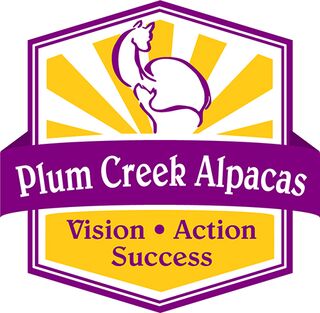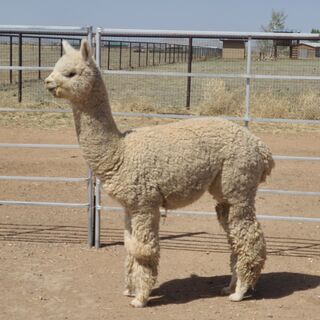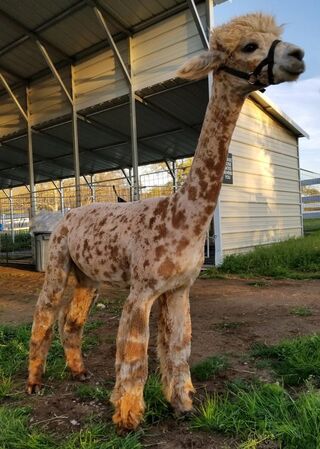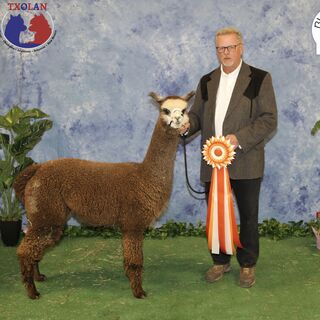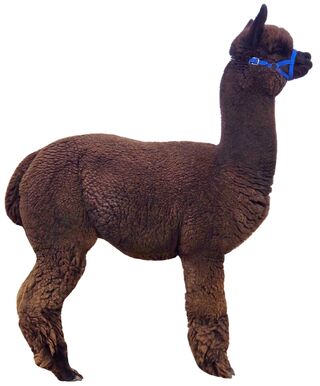FEEDING AND HAY FOR ALPACAS
FEEDING AND HAY FOR ALPACAS
Feeding and hay for Alpacas is something every Alpaca owner deals with daily. Learn how we have fed ours.
General Tips
Grass and hay are the most important things your Alpacas should eat. Unfortunately most areas in Arizona doesn't allow grassy fields, so we are on dry lots and feed hay 100%. Be sure that you have multiple feeding stations, especially as your herd grows. This will help the smaller/younger/more timid Alpacas not be chased away by the bullish ones.
We often see social media questions and answers about what to feed for treats. We err on the conservative side. While Alpacas will eat several things, we only feed hay and formulated Alpaca feeds. Many of our friends will feed vegetables like carrots, melons, cabbage, and other things but we do not. We stick with hay and alpaca pellets..
Hay: The Most Important Choice
In Arizona feed Orchard Grass hay if possible from Colorado or farther north (concern with local hay is valley fever). We utilize 100-110 lb. bales of Orchard Grass hay. As Alpacas are native to elevations ranging from 10,000' to 16,000' their normal intake is cool season grasses. Our hay comes from Oregon or Colorado. It maintains high protein levels in storage and is a wide-bladed cool season grass that Alpacas will eat with little waste. Orchard Grass is also high in selenium which Alpacas need.
Have your hay supplier provide an analysis. 12-13% protein is what we always hope to get. It maintains that level longer in storage than many other hay types. You will find that the 2nd and 3rd cutting bales are always better than 1st cutting. It also includes the nutrient selenium which Alpacas require. Our supplier is Dane Cusimano at Rolling Hills Stables in Chino Valley, AZ. He has consistently provided us with the best hay and will even deliver and stack your order for a reasonable fee in his trade area.
Other Hay Options
Some people use Bermuda hay by choice or necessity. It tends to be a lot messier as the blades are so thin. It can make Alpaca fiber a little dryer than Orchard Grass hay. Of course, it is significantly less expensive than Orchard Grass. And that is an important consideration for many folks, but be sure it comes from Colorado or farther north. (concern with local hay is valley fever)
Timothy hay is acceptable in a pinch. It’s in the same family as Orchard Grass. But the seed heads will be a nuisance by getting caught in their topknots. We’ve used it when decent Orchard Grass was not available.
Fescue PASTURE causes problems, but not fescue HAY. The endophytes that cause the trouble live at the very bottom of the stem close to the ground. When hay is harvested the bottom inch or two is left behind, so the endophytes do not usually make it into the hay.
We have always fed square bales. From about 55 lbs. to 120 lbs. We’ve never used huge square bales or round bales. Some people do.
Feed hay out of the wind and rain, and in sunshine only when temperature appropriate. We use feed boxes with high sides to protect from winds. Crias eating hay will need lower side boxes.
Never feed hay that has any sign of mold. Store it appropriately to avoid mold from developing. Be very careful if your hay has been exposed to rain as mold can develop. Also, be sure to never stack it wet as spontaneous combustion can result.
NAG Bags / Slow Feeders
We use high side feed boxes to reduce loss from the winds here.
NAG Bags (slow feeder netted bags) in a large 100-gallon Rubbermaid watering container to reduce hay waste. It has saved us a lot of money. They are available in three-hole sizes. We use the 1.5″ size. Off brands have been a waste of money
Always inspect NAG Bags for holes and repair as needed immediately. They come with some repair materials attached. When you receive your new bags remove those and hang them up in your shed where you will not forget where they are when you need them.
We have seen warnings on these types of feeding bags. It seems that some ranchers have had an animal strangled because of a worn hole. That’s not a problem with the product. It’s a problem with not keeping it in good repair.
We also have a fixture that has a removable metal grid. A square bale will not fit into it, so we place flakes into it. The grid slides out near the top through a slot above the manufacturer’s brand logo. As it descends, they cannot turn it over or remove it. This also saves hay, but we fill it more often than the NAG bags.
How to Store and Feed Pelletized and Shredded Products
To avoid any tragedies your non-hay feed supplements should have a double layer of protection! We have friends that have had an Alpaca get into their feed, overeat, and then die from the resulting acidosis and bloat.
We store pelletized and shredded feed that comes bagged in their factory sack. Those bags go into a lockable plastic container; we utilize large black plastic trash cans that have Snap-On lids. We then store those feed cans in our tack/feed rooms.
Feeding rails should be very low to the ground—no more than 12-18″. .
We utilize hard plastic feeding trays that can be hung over a 2×4 or on moveable panel railing. We also use soft rubber bowls, but be aware some Alpacas have a negative reaction to the rubbery products.
Pelletized Feed Supplements
We feed Country Feeds® Llama & Alpaca Feed from Cal-Ranch to both sexes as appropriate. Mazuri feed has multiple versions from Mazuri they offer if cost is a consideration. (Alpaca & Llama Maintenance Diet – 50 lb. and less expensive, Alpaca Growth & Repro – 40 lb., Alpaca Crumbles – 40 lb., Alpaca Chews – 40 lb., and other supplements.)
And yes, you will find respected and knowledgeable vets who will disagree with our choice to feed Country Feeds daily. We feed these pellets with our tours 5 day per week.
Some people believe that too much feed will “blow out” their fiber—that means that their fiber micron is larger. We have not experienced this and considering that it has been shown that a large portion of fiber micron is influenced by:
• genetics,
• by in utero fiber cell development,
• by environmental effects,
• and by other forage intake,
We have chosen to provide a balanced food supplement to ensure good Alpaca health.
There’s a chart on Mazuri feedbags about how much to feed. Alpacas require 1.5% to 2% of their body weight in intake each day. Preferably that is primarily from grazing and hay—like 90%. Feeding too many pellets by weight can cause digestive and choking issues. Feed dietary supplements like Mazuri by weight not by volume.
Recovering an Emaciated Alpaca
If you have obtained an emaciated Alpaca, be very careful not to give too much rich food too fast. You should start with good quality hay. Do not give pellets or Calf Manna at first. If you try to get a skinny Alpaca back a proper weight too fast you can harm or even kill it. A good loose mineral mix will ensure that it is getting needed nutrients.
Of course, in dealing with an overly skinny Alpaca please make sure it is chewing cud. Probiotics should help but if he is still not chewing cud, he may need a transfusion. Once it is eating hay well and chewing cud consistently you can start adding some shredded beet pulp on a very gradual basis. You may well have to soak it if it has a bad molar. If you add too much rich food too fast it will colic. You are doing a very good thing for him.
Other Supplements for Skinny Alpacas
Shredded beat pulp is often recommended as an effective method of adding weight to a skinny Alpaca. We have tried using it but not enough to comment about how it works. There’s certainly no problem in using it. Some ranchers soak it. Others don’t. We do.
While Alfalfa is technically a baled legume hay, we list it as a supplement. It should not be used as the primary hay source as it has too much protein and is sure to make them gain weight. Be careful when using it during the summer as it is higher in protein which heats up the Alpacas’ digestion. Our problem with it was that it had a large amount of very sharp stem waste. Our Alpacas only wanted to eat the tiny leaves.
According to the supplier’s website, “Chaffhaye is premium bagged, Non-GMO Alfalfa sold in 50-pound bags that capture the key characteristics of alfalfa, while also offering a guaranteed level of nutrition. It is ideal for ensuring maximum health and well-being of all classes of horse, deer, goat, llama, chickens, camelid, and other exotic animals.” While we have not used it, some other ranches in Texas have.
Some senior Alpacas have molar issues and have a hard time even eating Orchard Grass hay as soft as it is. You will find wads of gummed up hay wasted in the feeder and on the floor. Many have recommended Equine Senior feeds (which is mostly shredded beat pulp) as a solution. We’re getting to this situation but don’t have personal experience with it… yet.
Less Desirable Pelletized Feeds/Dangerous Feeds
There are ranches that swear by Calf Manna. We have researched this supplement and found that it is not specifically labeled for use in camelids. While copper toxicity concerns have relaxed through the years for Alpacas, it is still too high for us. However, we have utilized it for a brief time on specific animals. An article on Alpacas and Copper can be found at:
https://extension.psu.edu/copper-nutrition-in-camelids
Pelletized hay (alfalfa) products are not recommended for ruminating animals like Alpacas and cattle. Pellets are made for horses which do not have a rumen. The rumen needs longer pieces of hay to form the mat that is essential for a proper functioning rumen. The hay in the pellets has been chopped much to fine for this to happen. Also, it is usually the poorest quality alfalfa. We do use this item in our mash for pregnant females near due date.
Cracked corn is a definite “NO” for Alpacas. All corn can cause ulcers in Alpacas as we understand it. Too much of it can also cause acidosis.
If you raise chickens, please know that medicated chicken feeds can be lethal to Alpacas. Take appropriate steps to ensure that Alpacas have no access to your chicken’s feed.
Alpaca Minerals
Many camelids knowledgeable veterinarians recommend, and ranchers provide Alpaca Minerals with brand names like Stillwater 104, or Dr. Evans. Minerals can generally be ordered online. We use Gold Blend from https://llamaproducts.com/
WATERING https://www.plumcreekalpacas.com/page/10278/watering
Thank you for permissions to use this information. https://www.facebook.com/aubrey.oaks.alpacas
Thursday, January 11, 2024
